02: The Reel Drag
Between The Lines - Ch 04: Setting The Drag
We have covered the gear used in sport and game fishing in quite some depth with discussions on the actual gear and exercises that will improve angler technique. The advanced angler exercises will have aided in being smooth and powerful in pumping technique. Unfortunately, there is no way of replicating the actual fight with a fish to fully understand the gear and techniques used, let alone how to best use it to advantage. At this stage, a further understanding of the tools used is necessary to complete the task at hand.

The spool of a game reel and the way the drag system interacts is often misunderstood, yet it is quite simple and better understood if you test the reels yourself. In doing so, you will soon understand that not all reels are created equal. I can’t understand why there are any other game reels sold apart from Shimano’s Tiagra and TLD 2 speed.
Throughout this CD we have discussed some pretty aggressive angling techniques which can in reality only be accomplished if you understand the tactics, and further still, understand the gear you are using.
Let’s think of the spool of a game reel as a wheel, say a bicycle wheel, with an outside rim and a hub. The wheel turns easily by pushing the outside rim with the palm of the hand, but trying to turn the wheel with one finger pushing a spoke close to the hub is much more difficult.
Once the spool or wheel’s motion is started it is easy to keep it turning, though it is still much easier applying force to the outside of the wheel than close to the hub to maintain or increase the speed of rotation. The initial difficulty in getting the wheel moving is called inertia. Indeed, part of Newton's first law of motion states that "An object at rest tends to stay at rest.”
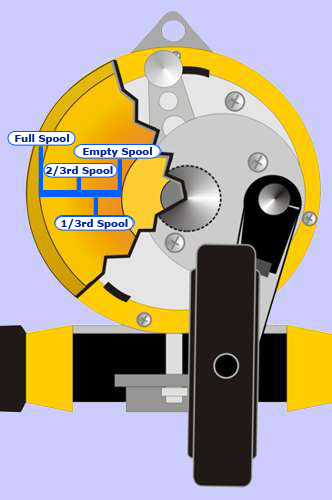
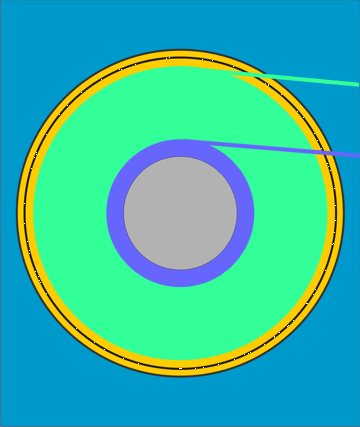 This is no different when we use the same principle on a game reel spool. The drag is set using a full spool of line as shown by the green line. As it is close to the outside rim of the spool it takes far less force to turn the spool than it would take to turn the spool where the blue line is closer to the hub of the spool, remembering the drag setting, that is friction on the spool, remains constant.
This is no different when we use the same principle on a game reel spool. The drag is set using a full spool of line as shown by the green line. As it is close to the outside rim of the spool it takes far less force to turn the spool than it would take to turn the spool where the blue line is closer to the hub of the spool, remembering the drag setting, that is friction on the spool, remains constant.
To show this clearly we will look at various results obtained using a Shimano Tiagra 20 with 8kg Stren High Impact Tournament Line. The test was done on a full spool, at two-thirds full, one-third full and right at the bottom of the spool. Note the measurements in millimetres are taken on the line capacity of the reel, not the diameter of the spool.
The spool of the reel is 28mm. It is normal for game reels to be filled with line leaving a space for either leaders or novices who can’t level the line effectively. This is to prevent the line or leader getting jammed between the spool and reel housing. In this case, full spool diameter was 4mm less than the spool diameter that is 24mm, which is about normal. The drag was then set at 3kg at normal drag setting speed. Though please note that in the following, the scales were pulled slowly with just the line ticking off very slowly. At any speed, the inertia breaks the line. Note that in the original setup the drag was set at 3kg which is a little high for 8kg. This is apparent now that with just a few turns of line left on the spool, the line will break very easily with the slightest increase in speed. The understanding of taking the reel, line and rod to their limits can only be understood by exercises and experiments such as this.
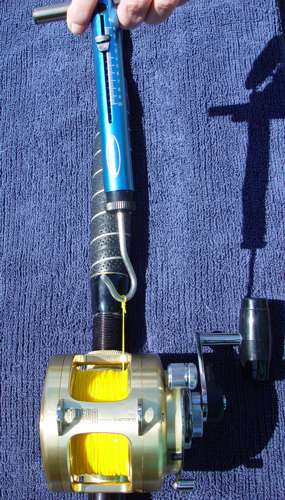 |
 |
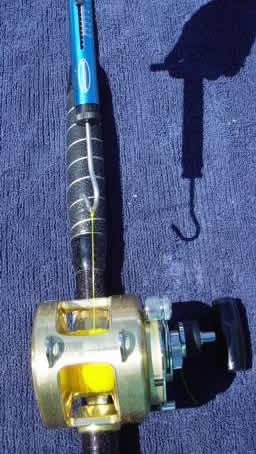 |
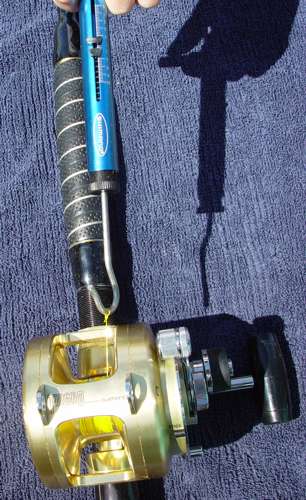 |
| Full Spool: Pull is at 24mm, 2kg drag |
Two-Thirds Full: 16mm, 4kg drag |
One-Third Full: 8mm, 6kg drag |
Just on empty 0mm, 7kg drag |
|
At any speed, the inertia breaks the line if you jerk the drag |
Game reel spools are heavy by nature as the build-up of pressure of stretched nylon wound on the spool is enormous. In addition, any distortion of the spool results in variable drags at the very least, and greater discrepancies on inferior reels. The engineering tolerances in top-of-the-line game reels are minute. They truly do show engineering excellence.
The ideal time to do these experiments is when changing line, as the line is usually discarded in any case, due to the detrimental effects of salt crystals building up over time. Playing around with drag settings and line speed at various stages of the line load of the reel will show exactly what to expect from your reel and what drag settings to apply, based on the speed of the line and how much line the fish has out at any stage of the fight.
The choice of the rod can affect the drag significantly. Non-rollered guides will increase drag to some extent, depending on the angle of the rod. The closer the rod is held to the direction of the line the less influence it will have on drag. Even the angle of a rollered rod will affect the drag settings, not because of friction, but because if a rod is bowed to the fish it will ease the shock of inertia.
This is a very important point to note. If the rod is held say at 45 degrees when a fish is running, the drag is still set on whatever, say a third, and the fish has gone a long way on this run, say two thirds the spool capacity in one long run. The spool stops turning, the fish has either stopped or slowed and the boat is now backing up faster in the direction of the fish - faster than the fish is swimming - and you are recovering line and all seems well. Then the boat slows or the fish surges on another run, in any case, the line now wants to turn the spool. If nothing is done to the drag setting, in most cases, the line will break. As the pressure comes on the rod, let the fish pull the rod down, this will cushion the inertia to a large extent. This is not the case if the rod is fully loaded at normal strike drag. A rod should have some cushioning in reserve at the highest drag settings you intend to use.
If the fish is surging quickly then you should back off the drag. If you have done the experiments, you’ll have a pretty good idea of how much to back off the drag depending on how full the spool is and at what speed the spool is turning.





